Temporal Variability of Major Stratospheric Sudden Warmings in CMIP5 Climate Change Scenarios
Abstract
1. Introduction
1.1. Background on SSW Dynamics
1.2. SSWm Under Climate Change and Modeling Challenges
2. Data and Methods
3. Results
3.1. Analysis of the Annual Mean Frequency of SSWm Under Different Climate Change Scenarios
3.2. Analysis of SSWm Occurrence Frequency Using Moving Averages
4. Discussion
5. Conclusions
Author Contributions
Funding
Institutional Review Board Statement
Informed Consent Statement
Data Availability Statement
Acknowledgments
Conflicts of Interest
Abbreviations
| SSWs | Stratospheric Sudden Warmings |
| SSWm | Major Stratospheric Sudden Warming |
| Displacement-type SSWm | |
| Split-type SSWm | |
| CMIP5 | Coupled Model Intercomparison Project Phase 5 |
| CCMI | Chemistry–Climate Model Initiative |
| NH | Northern Hemisphere |
| CP07 | Charlton and Polvani (2007) detection criterion |
| RCP | Representative Concentration Pathway |
| WMO | World Meteorological Organization |
| CMCC | Centro Euro-Mediterraneo sui Cambiamenti Climatici |
| Met Office | UK Met Office Hadley Centre |
| IPSL | Institut Pierre-Simon Laplace |
| MPI-M | Max Planck Institute for Meteorology |
References
- Gimeno, L.; de la Torre, L.; Nieto, R.; Gallego, D.; Ribera, P.; García-Herrera, R. A new diagnostic of stratospheric polar vortices. J. Atmos. Sol. Terr. Phys. 2007, 69, 1797–1812. [Google Scholar] [CrossRef]
- Liberato, M.L.R.; Castanheira, J.M.; de la Torre, L.; DaCamara, C.C.; Gimeno, L. Wave Energy Associated with the Variability of the Stratospheric Polar Vortex. J. Atmos. Sci. 2007, 64, 2683–2694. [Google Scholar] [CrossRef]
- Castanheira, J.M.; Liberato, M.L.R.; de la Torre, L.; Graf, H.F.; DaCamara, C.C. Baroclinic Rossby Wave Forcing and Barotropic Rossby Wave Response to Stratospheric Vortex Variability. J. Atmos. Sci. 2009, 66, 902–914. [Google Scholar] [CrossRef]
- Waugh, D.W.; Sobel, A.H.; Polvani, L.M. What Is the Polar Vortex and How Does It Influence Weather? Bull. Am. Meteorol. Soc. 2017, 98, 37–44. [Google Scholar] [CrossRef]
- Mitchell, D.M.; Scott, R.K.; Seviour, W.J.M.; Thomson, S.I.; Waugh, D.W.; Teanby, N.A.; Ball, E.R. Polar Vortices in Planetary Atmospheres. Rev. Geophys. 2021, 59, e2020RG000723. [Google Scholar] [CrossRef]
- Matsuno, T. A Dynamical Model of the Stratospheric Sudden Warming. J. Atmos. Sci. 1971, 28, 1479–1494. [Google Scholar] [CrossRef]
- Charlton, A.J.; Polvani, L.M.; Perlwitz, J.; Sassi, F.; Manzini, E.; Shibata, K.; Pawson, S.; Nielsen, J.E.; Rind, D. A New Look at Stratospheric Sudden Warmings. Part II: Evaluation of Numerical Model Simulations. J. Clim. 2007, 20, 470–488. [Google Scholar] [CrossRef]
- Baldwin, M.P.; Ayarzagüena, B.; Birner, T.; Butchart, N.; Butler, A.H.; Charlton-Perez, A.J.; Domeisen, D.I.V.; Garfinkel, C.I.; Garny, H.; Gerber, E.P.; et al. Sudden Stratospheric Warmings. Rev. Geophys. 2021, 59, e2020RG000708. [Google Scholar] [CrossRef]
- Wu, R.W.Y.; Wu, Z.; Domeisen, D.I.V. Differences in the sub-seasonal predictability of extreme stratospheric events. Weather Clim. Dyn. 2022, 3, 755–776. [Google Scholar] [CrossRef]
- Hitchcock, P.; Simpson, I.R. The Downward Influence of Stratospheric Sudden Warmings. J. Atmos. Sci. 2014, 71, 3856–3876. [Google Scholar] [CrossRef]
- WMO/IQSY. International Years of the Quiet Sun (IQSY) 1964-65; WMO/IQSY Report No 6. Technical Report; World Meteorological Organization: Geneva, Switzerland, 1964. [Google Scholar]
- de la Torre, L.; Garcia, R.R.; Barriopedro, D.; Chandran, A. Climatology and characteristics of stratospheric sudden warmings in the Whole Atmosphere Community Climate Model. J. Geophys. Res. Atmos. 2012, 117, D04110. [Google Scholar] [CrossRef]
- Vorobeva, E.; Orsolini, Y. The impact of tropospheric blockings on duration of the sudden stratospheric warmings in boreal winter 2023/24. EGUsphere 2025, 2025, 1–18. [Google Scholar] [CrossRef]
- Ma, J.; Chen, W.; Yang, R.; Ma, T.; Shen, X. Downward propagation of the weak stratospheric polar vortex events: the role of the surface arctic oscillation and the quasi-biennial oscillation. Clim. Dyn. 2024, 62, 4117–4131. [Google Scholar] [CrossRef]
- Zi, Y.; Long, Z.; Sheng, J.; Lu, G.; Perrie, W.; Xiao, Z. The Sudden Stratospheric Warming Events in the Antarctic in 2024. Geophys. Res. Lett. 2025, 52, e2025GL115257. [Google Scholar] [CrossRef]
- Lawrence, Z.D.; Abalos, M.; Ayarzagüena, B.; Barriopedro, D.; Butler, A.H.; Calvo, N.; de la Cámara, A.; Charlton-Perez, A.; Domeisen, D.I.V.; Dunn-Sigouin, E.; et al. Quantifying stratospheric biases and identifying their potential sources in subseasonal forecast systems. Weather Clim. Dyn. 2022, 3, 977–1001. [Google Scholar] [CrossRef]
- Charlton-Perez, A.J.; Baldwin, M.P.; Birner, T.; Black, R.X.; Butler, A.H.; Calvo, N.; Davis, N.A.; Gerber, E.P.; Gillett, N.; Hardiman, S.; et al. On the lack of stratospheric dynamical variability in low-top versions of the CMIP5 models. J. Geophys. Res. Atmos. 2013, 118, 2494–2505. [Google Scholar] [CrossRef]
- Osprey, S.M.; Gray, L.J.; Hardiman, S.C.; Butchart, N.; Hinton, T.J. Stratospheric Variability in Twentieth-Century CMIP5 Simulations of the Met Office Climate Model: High Top versus Low Top. J. Clim. 2013, 26, 1595–1606. [Google Scholar] [CrossRef]
- Seviour, W.J.M.; Gray, L.J.; Mitchell, D.M. Stratospheric polar vortex splits and displacements in the high-top CMIP5 climate models. J. Geophys. Res. Atmos. 2016, 121, 1400–1413. [Google Scholar] [CrossRef]
- Lehtonen, I.; Karpechko, A.Y. Observed and modeled tropospheric cold anomalies associated with sudden stratospheric warmings. J. Geophys. Res. Atmos. 2016, 121, 1591–1610. [Google Scholar] [CrossRef]
- Kim, J.; Son, S.W.; Gerber, E.P.; Park, H.S. Defining Sudden Stratospheric Warming in Climate Models: Accounting for Biases in Model Climatologies. J. Clim. 2017, 30, 5529–5546. [Google Scholar] [CrossRef]
- Taguchi, M. A study of different frequencies of major stratospheric sudden warmings in CMIP5 historical simulations. J. Geophys. Res. Atmos. 2017, 122, 5144–5156. [Google Scholar] [CrossRef]
- Ayarzagüena, B.; Polvani, L.M.; Langematz, U.; Akiyoshi, H.; Bekki, S.; Butchart, N.; Dameris, M.; Deushi, M.; Hardiman, S.C.; Jöckel, P.; et al. No robust evidence of future changes in major stratospheric sudden warmings: A multi-model assessment from CCMI. Atmos. Chem. Phys. 2018, 18, 11277–11287. [Google Scholar] [CrossRef] [PubMed]
- Wu, Z.; Reichler, T. Variations in the Frequency of Stratospheric Sudden Warmings in CMIP5 and CMIP6 and Possible Causes. J. Clim. 2020, 33, 10305–10320. [Google Scholar] [CrossRef]
- Chávez, V.M.; Añel, J.A.; Garcia, R.R.; Šácha, P.; de la Torre, L. Impact of Increased Vertical Resolution in WACCM on the Climatology of Major Sudden Stratospheric Warmings. Atmosphere 2022, 13, 546. [Google Scholar] [CrossRef]
- Chávez-Pérez, V.M.; Añel, J.A.; Almaguer-Gómez, C.; de la Torre, L. Influence of Satellite and Presatellite Periods on the Validation of Major Sudden Stratospheric Warmings in Historical CMIP5 Simulations. Atmosphere 2025, 16, 628. [Google Scholar] [CrossRef]
- Hall, R.J.; Mitchell, D.M.; Seviour, W.J.M.; Wright, C.J. Persistent Model Biases in the CMIP6 Representation of Stratospheric Polar Vortex Variability. J. Geophys. Res. Atmos. 2021, 126, e2021JD034759. [Google Scholar] [CrossRef]
- Andrews, D.G.; Holton, J.R.; Leovy, C.B. Middle Atmosphere Dynamics; Academic Press: Orlando, FL, USA, 1987; pp. xi–489. [Google Scholar]
- Castanheira, J.M.; Barriopedro, D. Dynamical connection between tropospheric blockings and stratospheric polar vortex. Geophys. Res. Lett. 2010, 37, L13809. [Google Scholar] [CrossRef]
- Limpasuvan, V.; Richter, J.H.; Orsolini, Y.J.; Stordal, F.; Kvissel, O.K. The roles of planetary and gravity waves during a major stratospheric sudden warming as characterized in WACCM. J. Atmos. Sol.-Terr. Phys. 2012, 78–79, 84–98. [Google Scholar] [CrossRef]
- Sassi, F.; Liu, H.L. Westward traveling planetary wave events in the lower thermosphere during solar minimum conditions simulated by SD-WACCM-X. J. Atmos. Sol.-Terr. Phys. 2014, 119, 11–26. [Google Scholar] [CrossRef]
- Huang, J.; Tian, W.; Gray, L.J.; Zhang, J.; Li, Y.; Luo, J.; Tian, H. Preconditioning of Arctic Stratospheric Polar Vortex Shift Events. J. Clim. 2018, 31, 5417–5436. [Google Scholar] [CrossRef]
- Maycock, A.C.; Hitchcock, P. Do split and displacement sudden stratospheric warmings have different annular mode signatures? Geophys. Res. Lett. 2015, 42, 10943–10951. [Google Scholar] [CrossRef]
- Taylor, K.E.; Stouffer, R.J.; Meehl, G.A. An Overview of CMIP5 and the Experiment Design. Bull. Am. Meteorol. Soc. 2012, 93, 485–498. [Google Scholar] [CrossRef]
- Ayarzagüena, B.; Charlton-Perez, A.J.; Butler, A.H.; Hitchcock, P.; Simpson, I.R.; Polvani, L.M.; Butchart, N.; Gerber, E.P.; Gray, L.; Hassler, B.; et al. Uncertainty in the Response of Sudden Stratospheric Warmings and Stratosphere-Troposphere Coupling to Quadrupled CO2 Concentrations in CMIP6 Models. J. Geophys. Res. Atmos. 2020, 125, e2019JD032345. [Google Scholar] [CrossRef]
- Mitchell, D.M.; Osprey, S.M.; Gray, L.J.; Butchart, N.; Hardiman, S.C.; Charlton-Perez, A.J.; Watson, P. The Effect of Climate Change on the Variability of the Northern Hemisphere Stratospheric Polar Vortex. J. Atmos. Sci. 2012, 69, 2608–2618. [Google Scholar] [CrossRef]
- Hansen, F.; Matthes, K.; Petrick, C.; Wang, W. The influence of natural and anthropogenic factors on major stratospheric sudden warmings. J. Geophys. Res. Atmos. 2014, 119, 8117–8136. [Google Scholar] [CrossRef]
- Liang, Z.; Rao, J.; Guo, D.; Lu, Q. Simulation and projection of the sudden stratospheric warming events in different scenarios by CESM2-WACCM. Clim. Dyn. 2022, 59, 1–21. [Google Scholar] [CrossRef]
- Charlton, A.J.; Polvani, L.M. A New Look at Stratospheric Sudden Warmings. Part I: Climatology and Modeling Benchmarks. J. Clim. 2007, 20, 449–469. [Google Scholar] [CrossRef]
- Charlton-Perez, A.J.; Polvani, L.M.; Austin, J.; Li, F. The frequency and dynamics of stratospheric sudden warmings in the 21st century. J. Geophys. Res. Atmos. 2008, 113, D16116. [Google Scholar] [CrossRef]
- Bell, C.J.; Gray, L.J.; Kettleborough, J. Changes in Northern Hemisphere stratospheric variability under increased CO2 concentrations. Q. J. R. Meteorol. Soc. 2010, 136, 1181–1190. [Google Scholar] [CrossRef]
- Mitchell, D.M.; Charlton-Perez, A.J.; Gray, L.J.; Akiyoshi, H.; Butchart, N.; Hardiman, S.C.; Morgenstern, O.; Nakamura, T.; Rozanov, E.; Shibata, K.; et al. The nature of Arctic polar vortices in chemistry—Climate models. Q. J. R. Meteorol. Soc. 2012, 138, 1681–1691. [Google Scholar] [CrossRef]
- Gettelman, A.; Hegglin, M.; Son, S.W.; Fujiwara, M.; Tilmes, L.P.S.; Hoor, P.; Lee, H.; Manney, G.; Birner, T.; Stiller, G.; et al. Upper Troposphere and Lower Stratosphere (UTLS) in SPARC CCMVal, SPARC CCMVal Report on the Evaluation of Chemistry-Climate Models; Hokkaido University: Sapporo, Japan, 2010. [Google Scholar]
- Ayarzagüena, B.; Langematz, U.; Meul, S.; Oberländer, S.; Abalichin, J.; Kubin, A. The role of climate change and ozone recovery for the future timing of major stratospheric warmings. Geophys. Res. Lett. 2013, 40, 2460–2465. [Google Scholar] [CrossRef]
- Añel, J.A. The stratosphere: History and future a century after its discovery. Contemp. Phys. 2016, 57, 230–233. [Google Scholar] [CrossRef]
- Añel, J.A.; Cnossen, I.; Antuña-Marrero, J.C.; Beig, G.; Brown, M.K.; Doornbos, E.; Osprey, S.; Mutschler, S.M.; Souto, C.P.; Šácha, P.; et al. The Need for Better Monitoring of Climate Change in the Middle and Upper Atmosphere. AGU Adv. 2025, 6, e2024AV001465. [Google Scholar] [CrossRef]
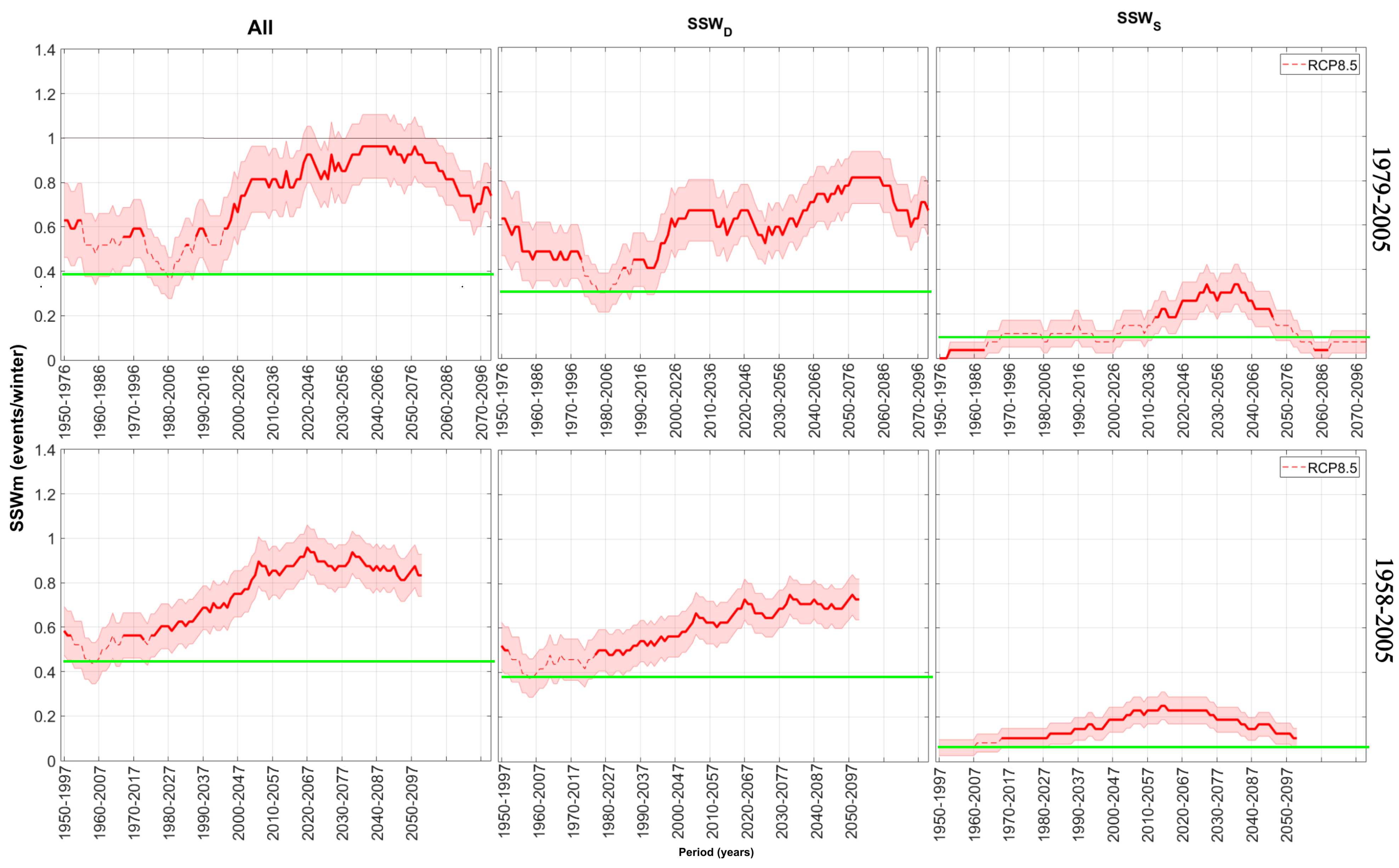
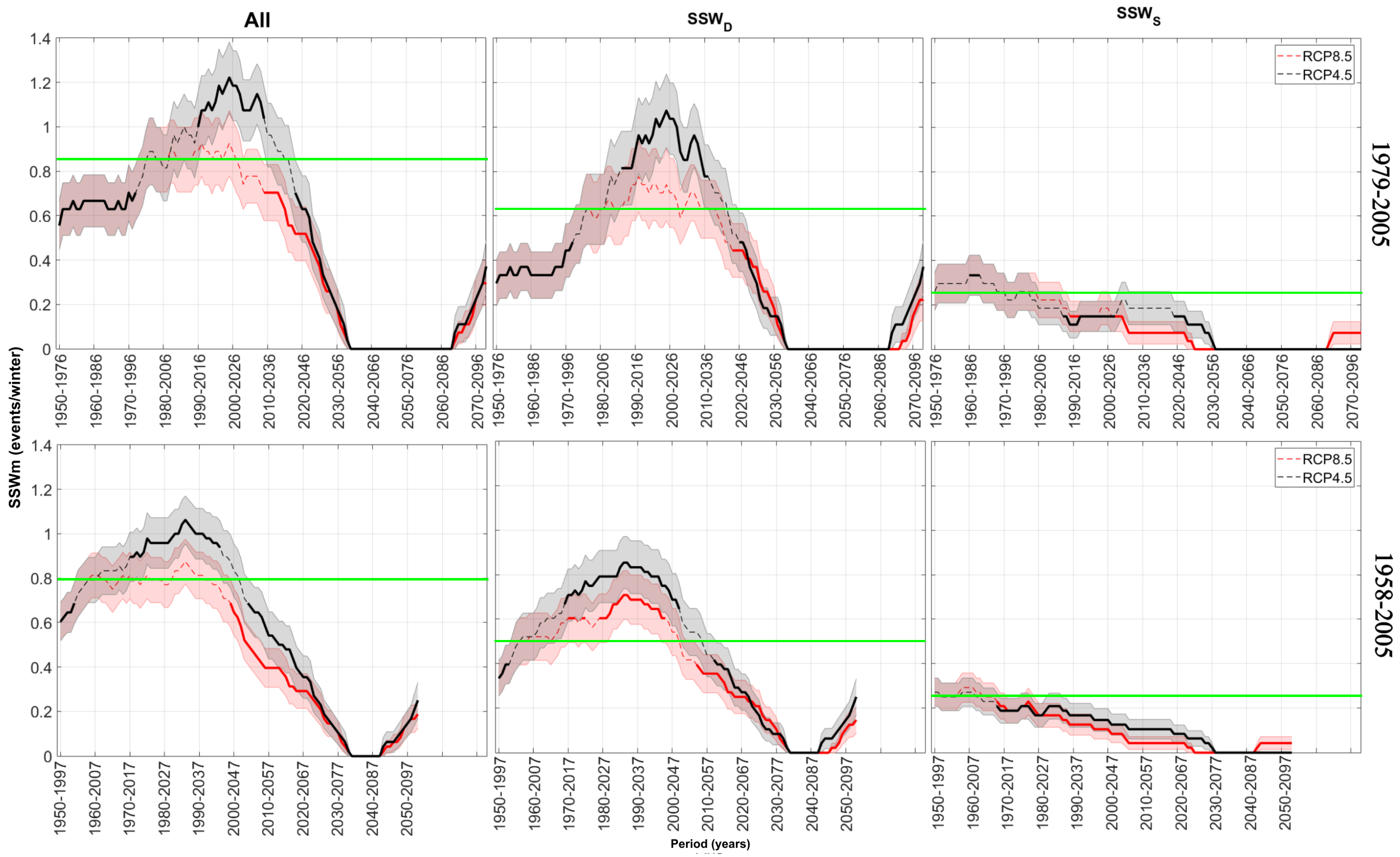

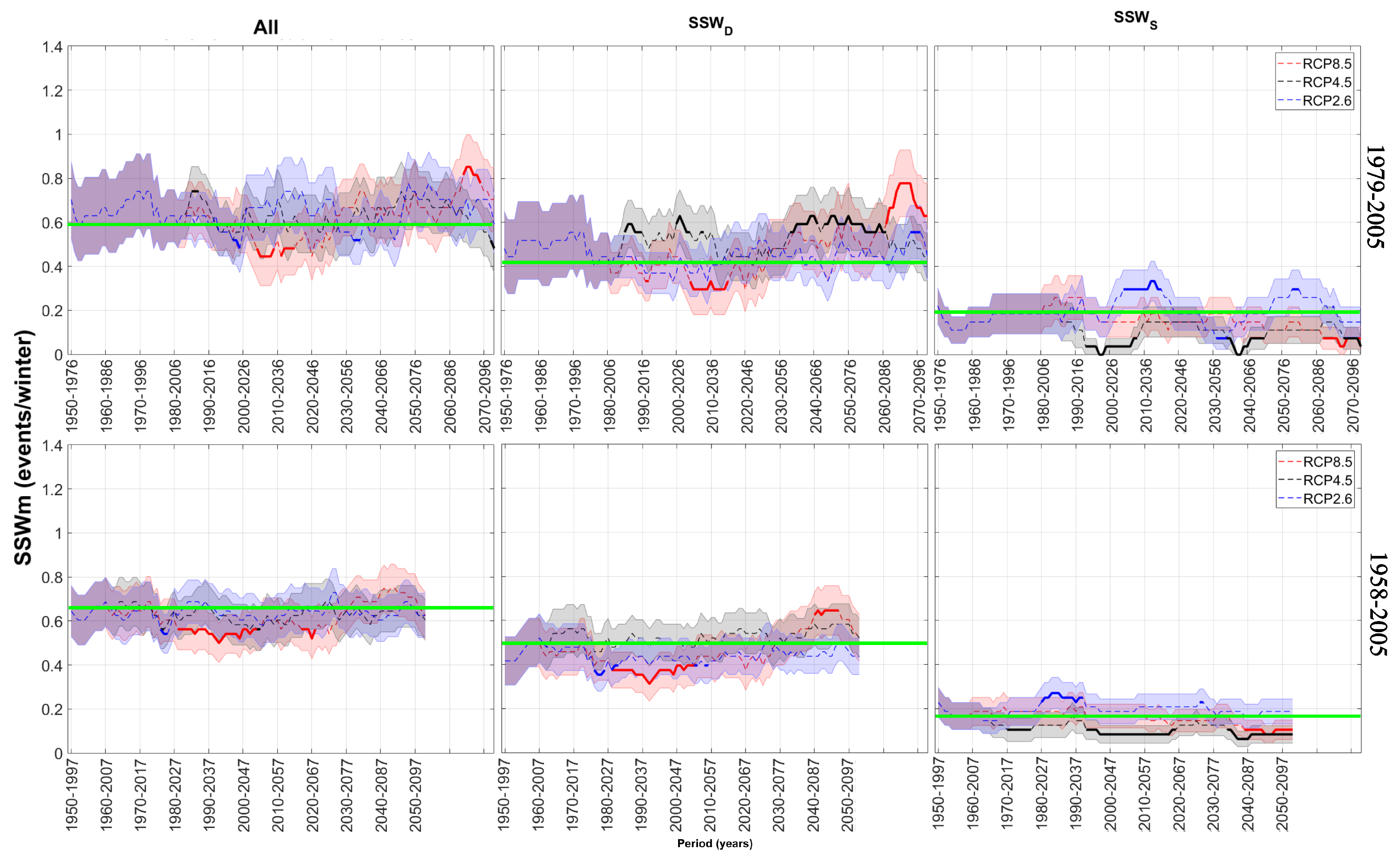
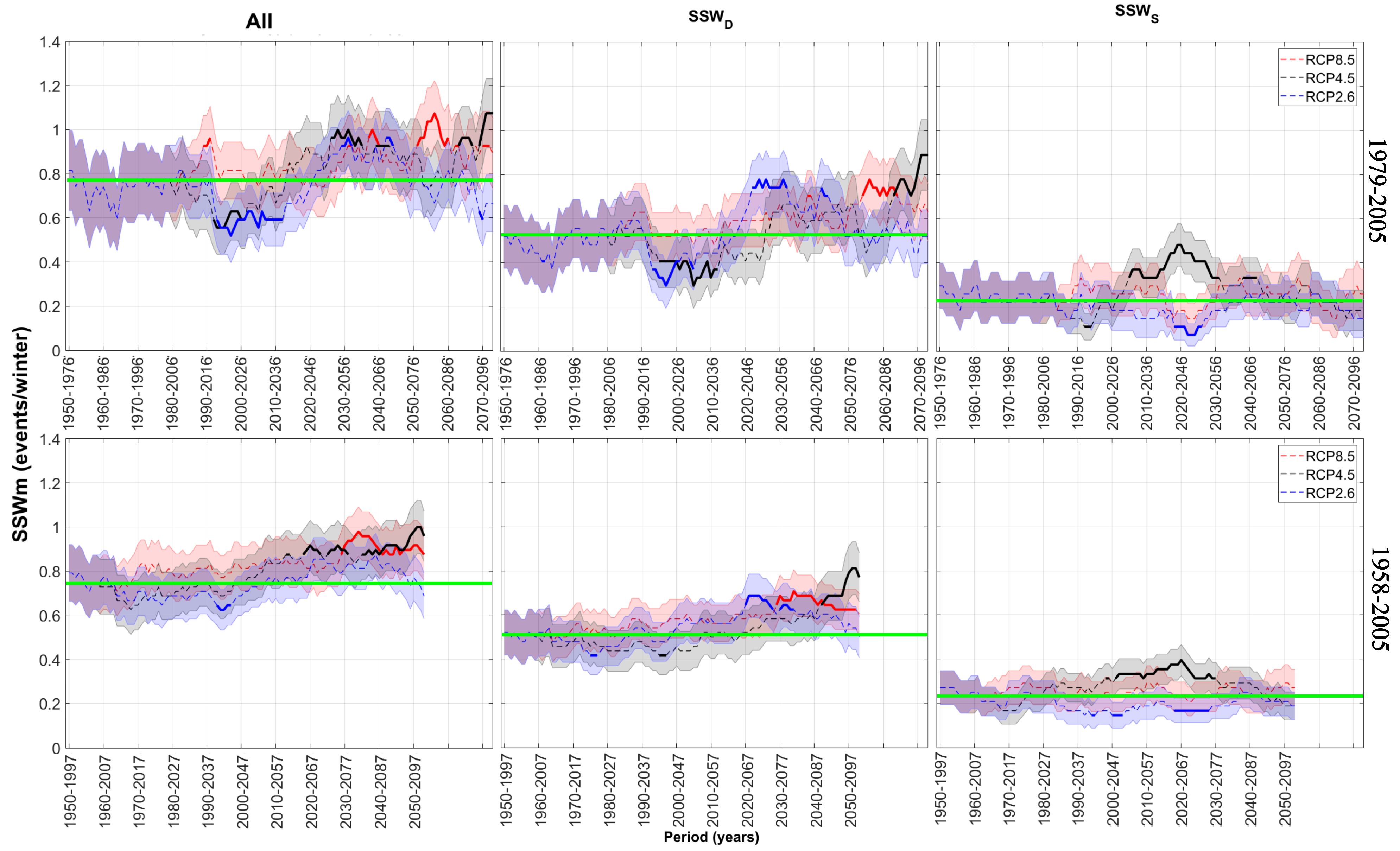
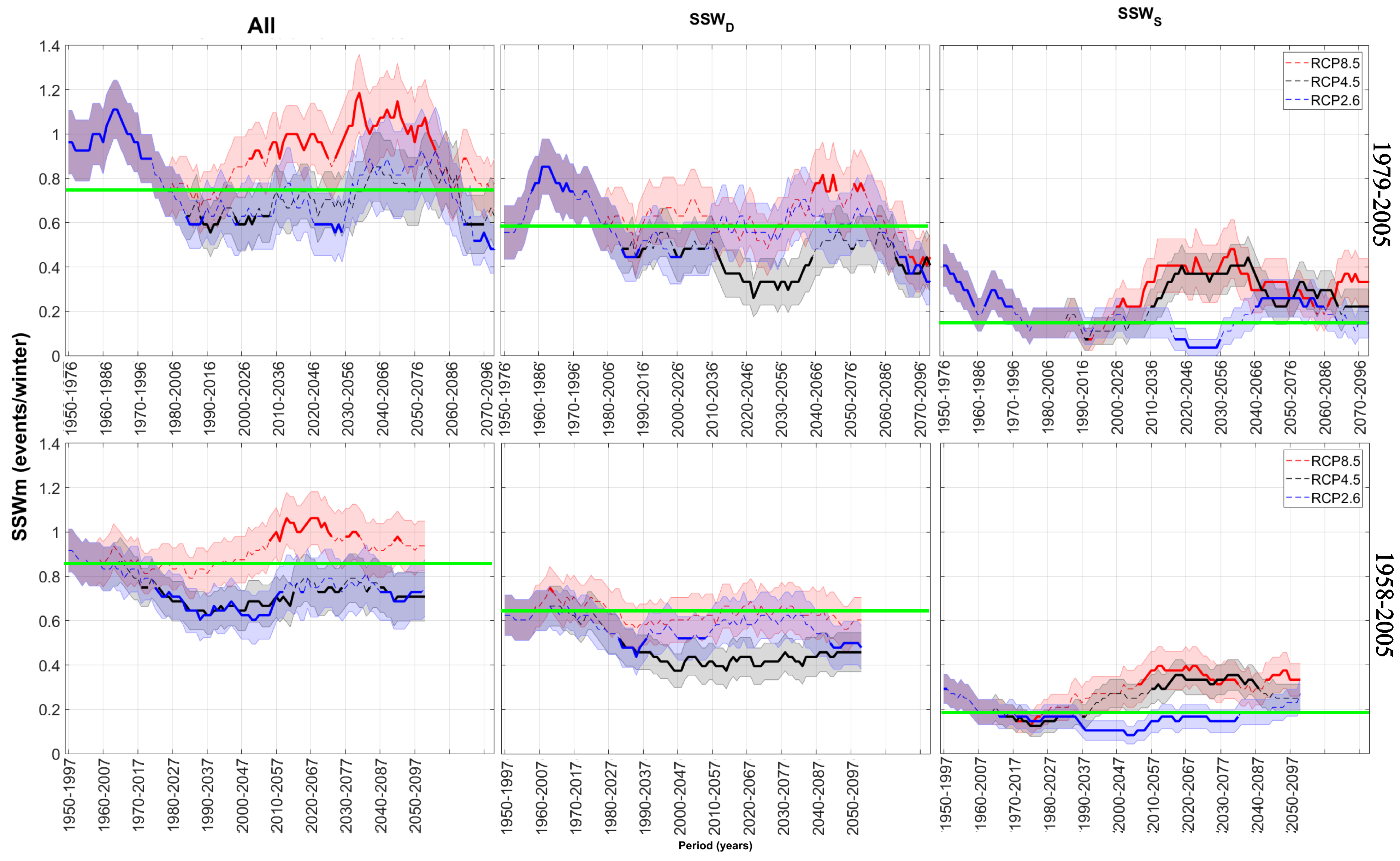
| Model | Modeling Center | RCP Scenarios | Horizontal Resolution (° lat × ° lon) | Vertical Levels | Model Top (km) | |
|---|---|---|---|---|---|---|
| 1 | CMCC-CESM | CMCC | 8.5 | 3.44 × 3.75 | 39 | 80.6 |
| 2 | CMCC-CMS | CMCC | 8.5; 4.5 | 3.71 × 3.75 | 95 | 80.6 |
| 3 | HadGEM2-CC | Met Office | 8.5; 4.5 | 1.25 × 1.87 | 96 | 84.1 |
| 4 | IPSL-CM5A-MR | IPSL | 8.5; 4.5; 2.6 | 1.25 × 2.52 | 39 | 70.4 |
| 5 | MPI-ESM-LR | MPI-M | 8.5; 4.5; 2.6 | 1.88 × 0.94 | 47 | 80.6 |
| 6 | MPI-ESM-MR | MPI-M | 8.5; 4.5; 2.6 | 1.88 × 0.94 | 47 | 80.6 |
| Model | 1979–2005 | 1958–2005 | RCP 8.5 | RCP 4.5 | RCP 2.6 | |
|---|---|---|---|---|---|---|
| 1 | CMCC-CESM | 0.41 (0.11) | 0.44 (0.09) | 0.84 (0.07) | – | – |
| 2 | CMCC-CMS | 0.81 (0.15) | 0.77 (0.10) | 0.33 (0.06) | 0.45 (0.07) | – |
| 3 | HadGEM2-CC | 0.48 (0.10) | 0.44 (0.08) | 0.72 (0.08) | 0.88 (0.08) | – |
| 4 | IPSL-CM5A-MR | 0.63 (0.12) | 0.67 (0.11) | 0.60 *, † (0.07) | 0.59 *, † (0.07) | 0.61 *, † (0.07) |
| 5 | MPI-ESM-LR | 0.78 (0.15) | 0.75 (0.12) | 0.85 (0.08) | 0.88 * (0.08) | 0.72 *, † (0.07) |
| 6 | MPI-ESM-MR | 0.74 (0.11) | 0.85 (0.10) | 0.93 † (0.08) | 0.69 * (0.07) | 0.68 * (0.08) |
Disclaimer/Publisher’s Note: The statements, opinions and data contained in all publications are solely those of the individual author(s) and contributor(s) and not of MDPI and/or the editor(s). MDPI and/or the editor(s) disclaim responsibility for any injury to people or property resulting from any ideas, methods, instructions or products referred to in the content. |
© 2025 by the authors. Licensee MDPI, Basel, Switzerland. This article is an open access article distributed under the terms and conditions of the Creative Commons Attribution (CC BY) license (https://creativecommons.org/licenses/by/4.0/).
Share and Cite
Chávez-Pérez, V.M.; Añel, J.A.; Almaguer-Gómez, C.; de la Torre, L. Temporal Variability of Major Stratospheric Sudden Warmings in CMIP5 Climate Change Scenarios. Climate 2025, 13, 207. https://doi.org/10.3390/cli13100207
Chávez-Pérez VM, Añel JA, Almaguer-Gómez C, de la Torre L. Temporal Variability of Major Stratospheric Sudden Warmings in CMIP5 Climate Change Scenarios. Climate. 2025; 13(10):207. https://doi.org/10.3390/cli13100207
Chicago/Turabian StyleChávez-Pérez, Víctor Manuel, Juan A. Añel, Citlalli Almaguer-Gómez, and Laura de la Torre. 2025. "Temporal Variability of Major Stratospheric Sudden Warmings in CMIP5 Climate Change Scenarios" Climate 13, no. 10: 207. https://doi.org/10.3390/cli13100207
APA StyleChávez-Pérez, V. M., Añel, J. A., Almaguer-Gómez, C., & de la Torre, L. (2025). Temporal Variability of Major Stratospheric Sudden Warmings in CMIP5 Climate Change Scenarios. Climate, 13(10), 207. https://doi.org/10.3390/cli13100207







